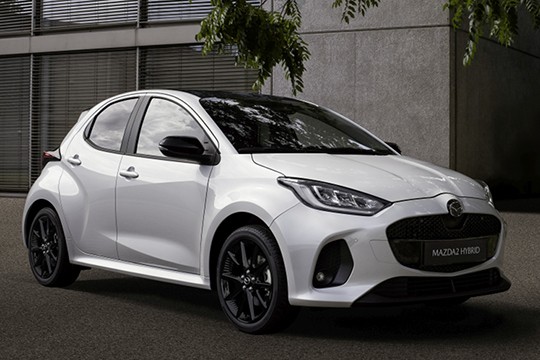Body style: Hatchback
Segment: Small
Infotainment: ![]() Apple CarPlay
Apple CarPlay ![]() Android Auto
Android Auto
Production years: 2023, 2024
 14 Photos
14 PhotosMazda unveiled the fourth generation of its small-sized vehicle, the 2, in 2023, and the brand’s aficionados were in shock since the car was, actually, a re-badged Toyota Yaris.
Toyota and Mazda joined forces, and it wasn’t for the first time. While the third generation of the Mazda2 was sold in several countries, including Canada, as a re-badged Toyota Yaris and Yaris sedan, on the fourth generation, they swapped places. As a result, the fourth generation of the Mazda2 became a hybrid and was a brand-engineered product for the Yaris. This happened since Mazda needed a hybrid vehicle, and it didn’t have enough time or money to develop one from the ground up. On the other hand, Toyota couldn’t say no to its partner. In 2015, the two Japanese automakers inked a deal, and eight years later, the final product entered the market after the third generation of the 2 was out and sent into retirement after a long and fruitful career that spawned across nine years.
Thanks to its size, the fourth Mazda2 fit into the B-segment vehicles class, which was very active and contested in Europe. To attract customers, the Mazda2 featured a sporty-looking front fascia with swept-back headlights and a grille that mostly resembled the one installed on its bigger siblings, the 6 and the CX5, which was flanked by a pair of scoops where the automaker installed the fog lamps. Furthermore, Mazda tried to make the car share at least some parts of this brand’s DNA instead of Toyota’s. As a result, customers could get it with a piano-black grille, door mirrors, roof, and B-pillars. Just like its twin sibling, the Yaris, the 2 was available as a five-door hatchback only. At the back, Mazda installed its badge on the tailgate and a trapezoidal-shaped lower apron integrated into the bumper.
The interior was also available with a wide choice of options. Customers could order the vehicle at a lower budget with a 9” display for the infotainment with an option for a 10.5” touchscreen placed atop the center stack. Fronting the driver was a digital instrument cluster with two dials for the speedometer and tachometer that flanked a TFT display that showed information from the car’s onboard computer. Moreover, Mazda provided the 2 with a 10-inch head-up display as an option. Despite the car’s urban destination, the automaker didn’t want its customers to feel like they were in a mundane vehicle and offered a set of bolstered front seats, which looked very sporty. In the back, the split-folding bench was wide enough for two adult-sized passengers, although legroom was not that big.
Mazda2 Hybrid was powered by Toyota’s 1.5-liter inline-three powerplant that ran in Atkinson cycle and a 59 kW electric motor. The total output of this system was 116 PS (114 HP), which were sent to the front wheels only via an e-CVT. Mazda2’s sporty look was confirmed by the stiff suspension and rigid bodywork, although it wasn’t a sports car; just a sporty five-door B-segment hatchback.
MAZDA 2 2023, 2024
- 1.5L e-CVT (116 HP)
MAZDA 2
1.5L e-CVT (116 HP)
ENGINE SPECS - 1.5L e-CVT (116 HP) | |
|---|---|
| Cylinders: | L3 |
| Displacement: | 1490 cm3 |
| Power: | 67.7 KW @ - RPM 92 HP @ - RPM 91 BHP @ - RPM |
| Electrical motor power: | 59 kw (80 hp) |
| Total maximum power: | 85.3 kw (116 hp) |
| Fuel System: | Turbocharged Direct Injection |
| Fuel: | Hybrid Gasoline |
PERFORMANCE SPECS | |
|---|---|
| Acceleration 0-62 Mph (0-100 kph): | 9.7 s |
TRANSMISSION SPECS | |
|---|---|
| Drive Type: | Front Wheel Drive |
| Gearbox: | e-CVT |
BRAKES SPECS | |
|---|---|
| Front: | Ventilated Discs |
| Rear: | Ventilated Discs |
FUEL ECONOMY (WLTP) | |
|---|---|
| Combined: | 54.7 mpg US (4.3 L/100Km) |
| CO2 Emissions (Combined): | 97 g/km |













